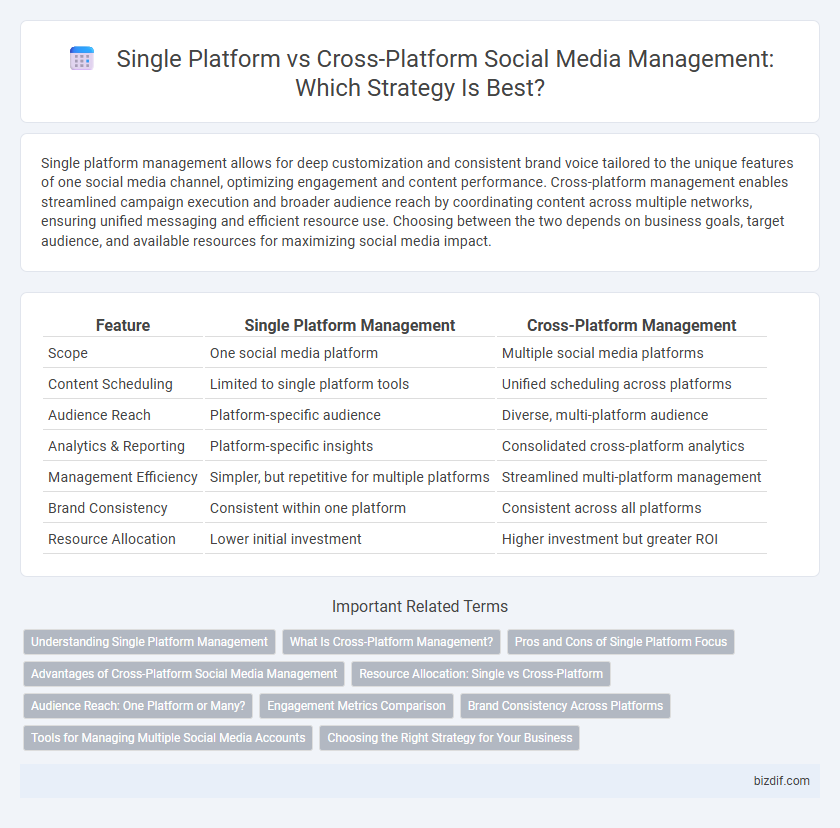Single platform management allows for deep customization and consistent brand voice tailored to the unique features of one social media channel, optimizing engagement and content performance. Cross-platform management enables streamlined campaign execution and broader audience reach by coordinating content across multiple networks, ensuring unified messaging and efficient resource use. Choosing between the two depends on business goals, target audience, and available resources for maximizing social media impact.
Table of Comparison
| Feature | Single Platform Management | Cross-Platform Management |
|---|---|---|
| Scope | One social media platform | Multiple social media platforms |
| Content Scheduling | Limited to single platform tools | Unified scheduling across platforms |
| Audience Reach | Platform-specific audience | Diverse, multi-platform audience |
| Analytics & Reporting | Platform-specific insights | Consolidated cross-platform analytics |
| Management Efficiency | Simpler, but repetitive for multiple platforms | Streamlined multi-platform management |
| Brand Consistency | Consistent within one platform | Consistent across all platforms |
| Resource Allocation | Lower initial investment | Higher investment but greater ROI |
Understanding Single Platform Management
Single platform management involves concentrating efforts on one social media channel, allowing deeper customization and engagement strategies tailored to its unique audience and algorithm. This approach maximizes platform-specific tools and analytics, enhancing content optimization and audience insight accuracy. Specialized management increases brand consistency and responsiveness on that single channel, driving focused growth and stronger community building.
What Is Cross-Platform Management?
Cross-platform management involves overseeing and coordinating social media content, scheduling, and engagement across multiple social media channels such as Facebook, Instagram, Twitter, and LinkedIn from a unified dashboard. This approach enhances brand consistency, streamlines workflow, and enables comprehensive analytics to measure performance across diverse platforms. Businesses leveraging cross-platform management benefit from increased reach, efficient content distribution, and cohesive audience interaction.
Pros and Cons of Single Platform Focus
Focusing on single platform management allows businesses to specialize content and engagement strategies tailored to one audience, enhancing brand consistency and deeper community connections. However, this approach limits audience reach and diversification, potentially restricting growth opportunities and data insights from varied demographics. Concentrating solely on one platform may also increase vulnerability to algorithm changes or platform-specific issues impacting overall social media performance.
Advantages of Cross-Platform Social Media Management
Cross-platform social media management enhances brand consistency by enabling unified messaging across multiple channels like Facebook, Instagram, and Twitter. It improves audience reach and engagement through tailored content optimized for each platform's unique demographics and algorithms. Integrated analytics provide comprehensive insights, facilitating data-driven strategies that boost overall campaign performance.
Resource Allocation: Single vs Cross-Platform
Resource allocation in single platform management is more streamlined, allowing for focused investment in specific tools, content creation, and audience engagement strategies tailored to one social media channel. Cross-platform management requires distributing resources across multiple channels, often necessitating diverse content formats, varied scheduling, and multi-channel analytics, which can increase complexity and demand higher budget and manpower. Efficiently balancing resource allocation ensures optimal performance whether concentrating efforts on one platform or expanding reach across several.
Audience Reach: One Platform or Many?
Single platform management allows for deep engagement within a specific audience, optimizing content tailored to user behavior on that channel. Cross-platform management expands audience reach by leveraging multiple social networks, increasing visibility and brand exposure across diverse demographics. Strategic use of several platforms ensures a broader market penetration, while focusing on one platform can maximize loyalty and influence within a niche community.
Engagement Metrics Comparison
Single platform management often yields higher engagement rates per post due to focused audience targeting and tailored content strategies specific to that platform's user behavior. Cross-platform management enables broader reach and diverse audience interactions, but engagement metrics like likes, shares, and comments may vary widely, requiring deeper analysis of platform-specific performance indicators. Data from tools such as Sprout Social and Hootsuite show that while single platform campaigns excel in engagement intensity, cross-platform approaches drive volume and varied user engagement types.
Brand Consistency Across Platforms
Maintaining brand consistency across platforms requires a cohesive strategy that aligns messaging, visuals, and tone on each social media channel. Single platform management allows deep customization tailored to one audience, but cross-platform management ensures unified brand identity and broader reach. Tools like Hootsuite and Sprout Social enable streamlined scheduling and analytics, helping brands preserve consistent engagement and reputation across multiple networks.
Tools for Managing Multiple Social Media Accounts
Cross-platform management tools such as Hootsuite, Buffer, and Sprout Social enable seamless scheduling, monitoring, and analytics across multiple social media accounts, enhancing efficiency and consistency. Single platform tools like Facebook Business Suite offer specialized features tailored to individual networks but lack the unified dashboard available in cross-platform options. Investing in comprehensive management tools streamlines workflow, improves content coordination, and maximizes audience engagement across diverse social channels.
Choosing the Right Strategy for Your Business
Single platform management allows businesses to concentrate resources on mastering one network, ensuring deep engagement and tailored content that aligns with specific audience behaviors. Cross-platform management broadens reach by distributing content across multiple channels, leveraging varied demographics and boosting brand visibility on LinkedIn, Instagram, Twitter, and Facebook. Selecting the right strategy depends on business goals, target audience distribution, budget constraints, and the ability to maintain consistent brand messaging across platforms.
Single platform management vs Cross-platform management Infographic

 bizdif.com
bizdif.com